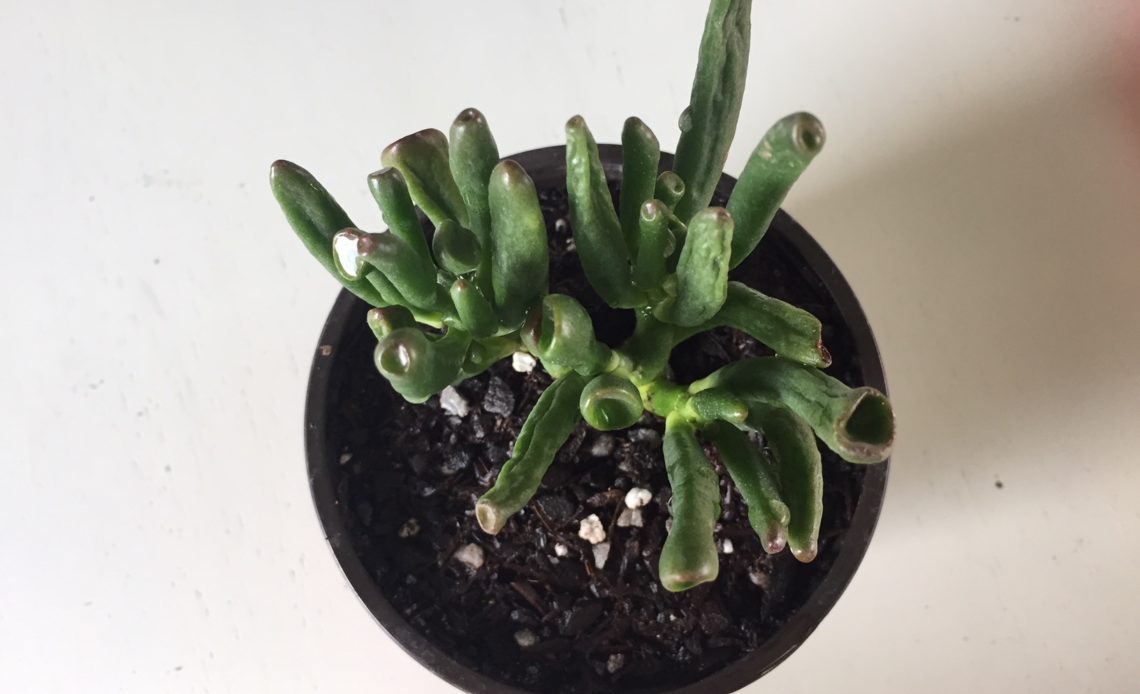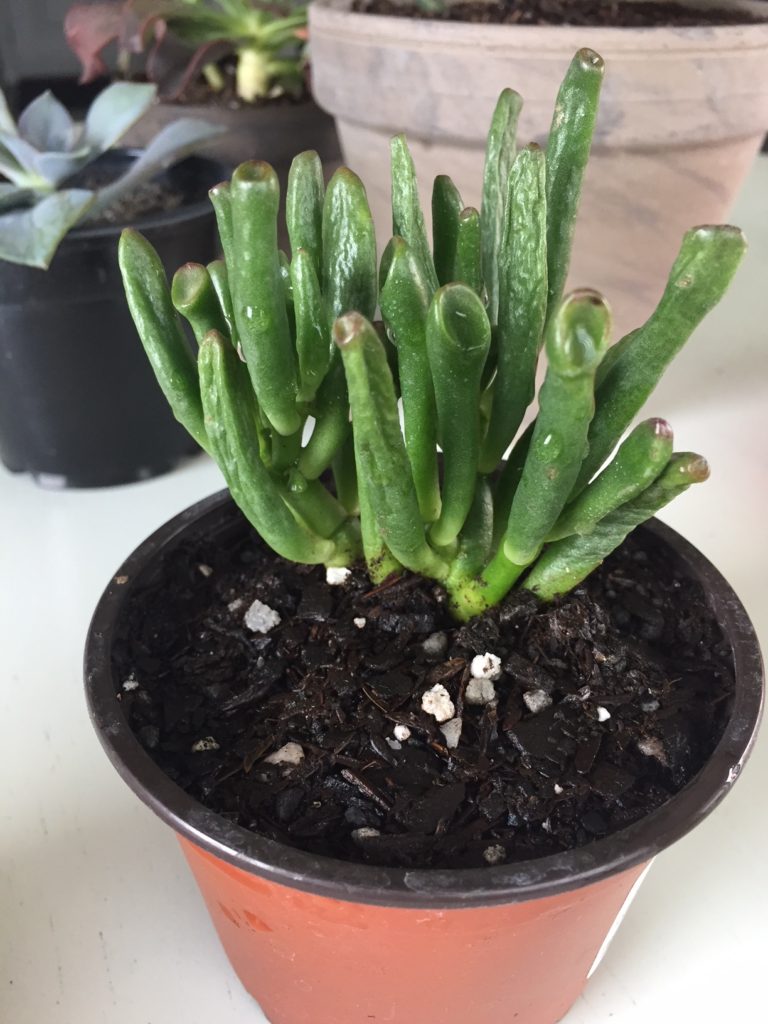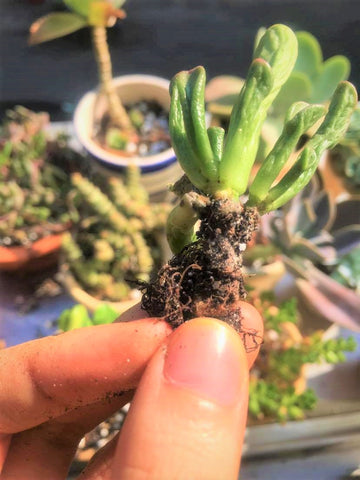Jade should be watered every two to three weeks. In between waterings, let the soil dry out. Gollum jade grows well in average rooms between 55°F and 80°F and prefers 4 hours of direct sunlight. To avoid root rot, plant gollum jade in soil suitable for succulent and cactus.
Succulents made of gollum jade require very little maintenance and grow exceptionally well indoors as house plants.
To maintain your plant healthy, read on for all the growth tips for gollum jade.
Plant profile for the Gollum Jade Succulent (Crassula ovata)
| Care/Requirements | Jade “Gollum” (Crassula ovata) Takes Good |
| Sun: | It thrives in strong indirect light and grows best in at least four hours of direct sunlight. |
| Water: | When the potting soil is dry, give it a nice soak of water. Normally, you should water once every two weeks, however this can change according on the weather. |
| The signs of overwatering are: | Gollum leaves develop a fragile, mushy texture and turn brown or yellow. |
| Underwatering signs and symptoms: | Less voluminous and beginning to droop, the leaves get wrinkled. |
| Soil: | Require, gritty, well draining succulent and cactus soil to avoid root rot. |
| Hardiness: | Up to USDA zone 10, hardy. utilize horticultural fleece to resist light frost. flourishes indoors. |
| Containers and Pots: | grows and reproduces successfully in pots and containers that match the size of the root ball. |
| Active Season for Growing: | Despite being more active in the spring and fall, plants can grow all year long. |
| Dormancy: | high heat to conserve water by going dormant. Winter growth is delayed because of reduced light. |
| preferred range of temperatures: | at room temperature, grows well. can withstand a broad temperature range. Steer clear of frigid weather. The ideal temperature range is 55°F-80°F (13°C-27°C). |
| Feeding: | doesn’t need a lot of fertilizer. During their active development periods in the spring and fall, larger plants can benefit from feeding once a month. |
| When Fully Maturity: | grows relatively slowly but can reach heights and widths of more over one foot. if kept in a little pot or container, it stays little. |
| Flowering: | Under the correct circumstances, Gollum Jade can bloom in the winter with tiny white flowers. |
| Longevity: | reports of Crassula ovata species that live for more than a century. |
Table of Contents
How Much Sunlight For Gollum Jade?
Succulents called gollum jade are indigenous to Southern Africa, where they thrive in morning light followed by afternoon shade to shield them from sweltering heat.
To avoid the full intensity of the light throughout the day, gollum jade frequently grows on rocky hillsides in its natural habitat.
Due to this, gollum jade may grow very well as indoor plants in a window with direct sunlight and can even grow rather well (although more slowly) in brilliant indirect light.
The leaves of your gollum succulent turn pale green and become leggy if it receives too much shade.
In response to direct sunshine, the tips of gollum succulent leaves turn crimson or pinkish.
It can be a sign of stress from too much direct sunlight if the red hue covers the entire leaf.
Your gollum jade leaves turn crimson at the tips when exposed to the right amount of sunlight, and they maintain their lovely, compact shape rather than becoming lanky.
How to Water Gollum Jade (Crassula ovata)
Gollum succulent watering frequency:
Gollum jade is a drought-resistant succulent that is indigenous to South Africa. It thrives on stony, well-draining soils on slopes where there is little chance of rain.
In order to properly care for your gollum jade, it is crucial to mimic the soil moisture and watering patterns seen in the stone’s natural habitat.
Give gollum jade a good soak, allowing water to seep out of the drainage hole on the pot’s bottom. To meet the moisture needs of gollum jade and prevent root rot, let the soil entirely dry up before watering it once more.
According on the temperature and the circumstances in your house or yard, this usually involves watering your gollum jade once every 14 days or so.
Depending on how quickly the potting soil dries out, you should water your particular gollum plant at different intervals.
To determine how frequently to water your gollum jade at home, wet the soil well. Then, feel the dirt through the drainage hole in the bottom of the pot to gauge how damp it is.
If the soil is damp, wait a few days before watering and wait until the soil is dry.
The ideal time to water your gollum succulent with a good soak is when the soil feels dry.
How Much Should Gollum Jade Water?
Always water the soil generously (as opposed to lightly) so that any extra water drips out the bottom of the container.
In order for the roots to absorb the necessary moisture, this guarantees that the water has permeated the soil and reached them.
Symptoms of excessive irrigation
Gollum Jade is adapted to living in arid areas, therefore when they are grown by gardeners, they are more susceptible to overwatering than underwatering.
Overwatered gollum jade plants have leaves that turn yellow or brown and have a mushy texture. The leaves can have a drooping appearance.
Reduce watering and let the soil dry out if this happens to your gollum jade.
To guarantee proper drainage and prevent root rot, replace the soil with succulent and cactus soil.
(If your plant appears unhealthy, read my post on how to resuscitate a dying jade plant.)
Underwatering signs and symptoms:
The best indicator of a dry gollum jade is wrinkled leaves.
In reaction to drought stress brought on by insufficient or sparing irrigation, the leaves sometimes droop and wrinkle.
Excessive air movement from draughts, air conditioning, or forced air in the home can increase drought stress by sapping more moisture from the leaves and causing the soil to dry out more quickly.
As the moisture they are storing is used up, the leaves likewise appear thinner.
If this occurs with your gollum jade, increase the frequency of watering the plant (always make sure the soil dries out between bouts of watering to prevent root rot) and watch how quickly the soil dries, modifying your watering schedule as necessary.
The plant can recover in 2 or 3 cycles of watering if you water it generously and place the gollum in an area with strong wind or excessive air currents.
(Read my article how to water jade plants for all the best strategies for watering).
Best Soil For Gollum Jade Succulents
On its native South Africa, gollum jade succulents grow in sandy, well-draining soil on rocky hillside slopes.
Because of this, it is crucial to mimic the soil conditions of the plant’s native habitat because this drought-tolerant species does not survive being cultivated in moisture-retentive potting soil.
Plant your gollum jade plant in a specially formulated succulent and cactus potting soil with a bigger particle size and a well-draining porous structure, which is designed to match the soil profile of the succulents’ ideal circumstances.
For this drought-resistant plant, regular potting soil keeps too much moisture around the roots for an extended period of time, which results in the same symptoms as overwatering and can lead to root rot.
Pots and Containers for Gollum Jade Succulents
Despite growing very slowly, gollum jade plants can reach heights and widths of more than one foot, and larger pots encourage more development.
So your pot size actually depends on how huge you want the gollum succulent to be as it matures.
However, keep in mind that larger pots have more soil in them and can hold more moisture as a result, increasing the possibility of root rot.
To ensure efficient water drainage between watering sessions, it’s crucial to put your gollum jade in a pot with drainage holes in the base.
Although gollum jade can be grown in any kind of container, clay or terracotta pots are said to be the best since they are a bit porous and allow the soil to dry up more quickly than plastic containers.
Although gollum jade is a tough plant that can take some root entanglement in the pot, you should repot it into a larger container to avoid the roots obstructing the drainage holes and causing the water to drain too slowly.
Repotting can be done at any time of year, but it is best done in the spring.
Active growth and Seasonal Dormancy of Gollum Jade
Gollum jade succulents can withstand extreme temperatures, but during the hottest part of Summer, they can go into a state of dormancy (where the growth slows to lessen the demand for water) as a survival tactic to deal with hot, dry, and unfriendly conditions in their original Southern African environment.
The gollum jade slows down development in order to preserve resources, especially water, when summertime temperatures consistently surpass 80°F (27°C).
Since the plant requires less water when in dormancy, the succulent may be more vulnerable to root rot.
So even if the temperature is quite high in the summer, you shouldn’t necessarily water your lawn more frequently.
The gollum plant should be okay during its hibernation and start actively developing when the temps are colder as long as the potting soil dries out between bouts of watering.
Because there is frequently a balance between bright sunshine and the ideal temperatures for growth throughout spring and fall, gollum jade grows more quickly (though it still grows extremely slowly).
Due to shorter days and less intense light in the winter, gollum jade frequently grows more slowly and requires less hydration. In the winter, water your gollum jade once every two to four weeks.
Temperature Range and Rate of Growth
In the average range of room temperature of between roughly 55°F-80°F (13°C-27°C), gollum jade grows quite well.
However, gollum jade plants can withstand a wider range of temperatures, even occasional light frosts, though it is advised to protect them from frost damage with horticultural fleece because they can wither in subfreezing temperatures.
Greater temperature extremes can be tolerated by gollum plants that are bigger and more established.
The gollum succulent can go dormant in order to conserve water in temperatures above 80°F (27°C) for an extended length of time before starting to develop again in cooler conditions.
Although gollum jade succulents grow slowly, under the correct circumstances, they can reach heights and widths of more than one foot. Gollum jade plants have a lifespan of more than a century.
Gollum plants thrive in good lighting, so if you want to speed up growth, you may use an indoor grow light to supplement natural light.
Fertilizer for Gollum Jade
Although you should only feed succulents once a month in the growing seasons of spring and fall, fertilizer can be used to stimulate growth.
To minimize issues with overfeeding your succulents, I personally like to use a specialized succulents and cactus fertilizer (available from garden centers and Amazon). It has all the nutrients that zebra plants need at the proper percentages.
While the succulent is not developing as vigorously in the winter or during the summer’s high temperatures, avoid fertilizing.
Key Takeaways:
- Gollum jade thrives at room temperature, in stony, well-draining soil, and in direct or brilliant indirect light. Give Golum Jade a good soak of water and allow the soil dry in between applications.
- In specially made succulent and cactus soil, plant gollum jade. in a container with drainage holes in the bottom to let excess water drain and allow the soil to dry out in order to prevent root rot.
- Insufficient sunlight causes the leaves to turn light green and appear spindly, while too much sunlight can make the leaves entirely crimson. Gullum jade should be displayed in a bright, indirect light, ideally in the morning sun and afternoon shade.
- In the spring and fall, when temperatures are pleasant and there are more hours of better light, gollum jade actively grows. Due to less daylight hours in the winter, gollum jade succulents grow more slowly. In the summer, when temperatures are high, they may go dormant. To avoid root rot, water gollum drought-tolerant jade only when the soil is dry.
FAQ
What does a jade plant look like when it needs water?
It is a sign that the plant needs MORE water if it begins to drop its leaves, shrivels up, or develops brown spots on its leaves. The plant is receiving TOO MUCH water if the leaves start to wilt and become soggy.
How long can Jade plant go without water?
One of the most well-liked varieties of succulent is the echeveria, however due to its quickly drying soil, it requires constant watering. Jade Plants: In some situations, these plants can survive with even less regular deep watering cycles that take place roughly once a month on average.
Can a jade plant recover from being overwatered?
When jade plants are overwatered or underwatered, they can lose their leaves. You must mimic some of their growing conditions, with a focus on watering with a good soak then leaving the soil to dry out, well-draining soil, and some direct sunlight, in order to revive a dying jade plant (Crassula ovata).



